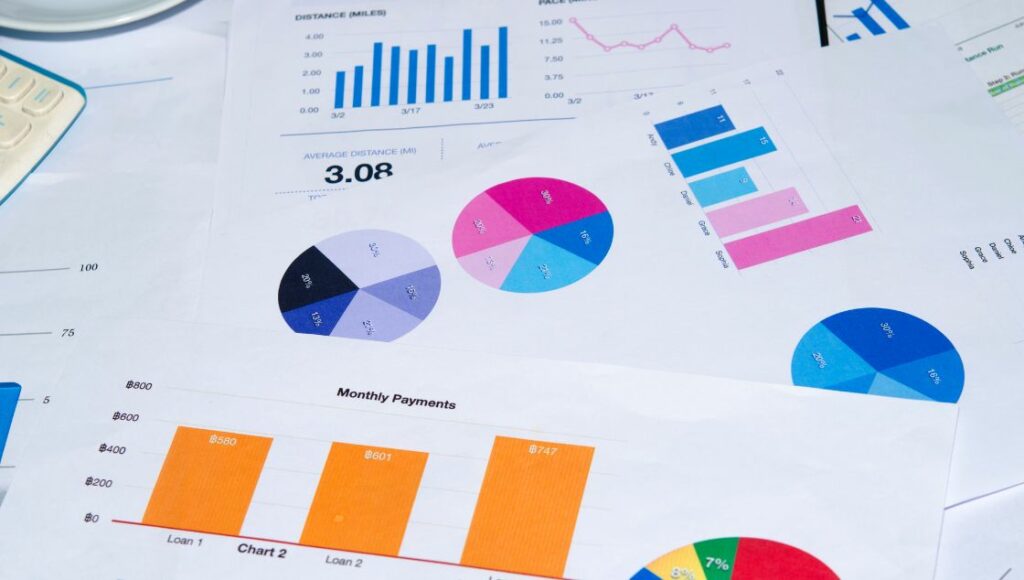Area Chart Insights: Uncover the Hidden Trends in Your Data!
Area charts are a type of graph that can reveal interesting insights and trends hidden within data sets. By shading the area between a line chart and its axes, area charts emphasize the magnitude and volume of changes in data over time. Although area charts may seem simple at first glance, they have unique benefits that make them versatile for data visualization and analysis. Read on to learn about them.
What is an Area Chart?
An area chart displays quantitative data visually by filling the area between a line chart and the axes with colors or textures. Unlike a simple line graph that only connects data points, area charts shade the space underneath to represent volume or magnitude. The outlined area illustrates metrics’ relative change and progression over a period.
Types of Area Charts

There are a few key types of area charts, differentiated by how the shaded areas interact:
1. Overlapping Area Charts
Overlapping area charts allow you to compare multiple data sets within the same timeframe by overlaying the shaded areas on top of each other. This makes it easy to visually assess how the metrics rise and fall in relation to each other. For example, you could use an overlapping area chart to see how revenue from different product lines changed monthly. The areas would show clearly where one product accelerated while another declined.
2. Stacked Area Charts
Stacked area charts arrange the shaded areas vertically, stacking them on top of each other within the same chart. This lets you discern how each data series contributes to a cumulative value. Stacked area charts help illustrate the breakdown and trends over time. For instance, a stacked area chart could reveal how different customer segments make up total sales while showing if their contributions have grown or shrunk across the year.
3. 100% Stacked Area Charts
100% stacked area charts function just like regular stacked area charts, except the vertical axis is converted to percentages, ensuring the cumulative stacked area always reaches 100% of the chart’s full height. This provides additional context on the proportional split for each segment rather than absolute values. For example, a 100% stacked area chart would showcase the percentage of total sales from each customer group and how those group contributions are changing.
4. Spline Area Charts
Unlike other area charts, which connect data points with straight lines or sharp angles, spline area charts use smooth Bézier curves to link points for a more organic shape. The curves help compensate for noise and fluctuations between data intervals, revealing the overall trajectory more clearly. Spline area charts are most useful for displaying general trends from less precise data capture. Population samples over longer timespans are situations where spline area smoothing would emphasize macro patterns.
Benefits of Using Area Charts
Area charts have aesthetic and functional advantages for data analysis:
1. Visual Appeal
Area charts stand out for their aesthetically pleasing visual format. Using color gradients, textures, or color blocking to fill the areas under the lines adds visual interest that draws viewers’ eyes to the trends. The shaded regions clearly separate the chart from a standard line graph, making it easier to discern changes and patterns. Strategic use of color also elicits intuitive interpretations of the data. For example, progressively darker red shades could represent hotter temperatures over time.
2. Trend Identification
The filled space under area charts emphasizes the progression of values in a straightforward way, smoothing out noise and minor fluctuations to make trends plainly evident. The slopes and shapes formed by the upper line and growth and decline in the shaded areas’ widths intuitively display increases, decreases, and rate of change. Its clarity builds understanding and quick recognition of the data’s narrative.
3. Comparative Analysis
When area charts have more than one data series, they can directly contrast metrics when using the overlapping/overlaid format. Viewers can analyze both the individual trajectories of measures and how they relate to each other through intersecting, diverging, or converging areas. This facilitates rich relative comparisons that are not possible in isolated charts.
4. Volume Representation
Area charts always include a vertical quantitative axis, using the amount of filled vertical space to represent accumulating values or volume. This draws attention to the total magnitude of change, which is harder to discern in line charts. When values represent quantities over time, area charts can resemble growing or shrinking containers, making volumes and degrees of difference more evident.
Key Components of Area Charts
While simple in concept, effective area charts have important defining features:
- Axes and Labels: Clear x and y axes indicate the metrics and timeframes.
- Color and Shading: Fills attract attention and convey meaning intuitively through gradients.
- Legends: Identify the meaning and data source behind colored areas.
Best Practices for Creating Area Charts
Here are some tips that you must follow for creating area charts:
1. Choosing the Right Data
Area charts work best for data sets that feature trends over time for one or more quantitative metrics. As the filled graphical area inherently represents growth and decline, area charts show their strength when applied to rising and falling values. Ideal data sets logically connect the measures and enough data points for slopes and trajectories to emerge. For example, area charts show revenue growth by month or website traffic by week.
2. Avoiding Clutter
The visual impact of area charts declines significantly when plotting too many data series. Limit area charts to 2-4 data sets maximum. Any more creates convoluted stacking or overlapping that obfuscates trends. Also, be selective in choosing only related measures to display rather than adding extra variables. Declutter labels, markers, and legends, too, removing excessive text where possible in favor of intuitive reliance on colors and axis values.
3. Utilizing Color Effectively
Strategic use of color sets area charts apart. Apply distinct fill colors and gradients to differentiate data series visually. Ensure adequate contrast between selections so trends stand out clearly as separate shaded zones. For example, use lighter and darker shades of complementary blues and oranges rather than similar shades of green or red. Standardize palettes between charts to preserve consistent meanings and support comparability.
4. Maintaining Comparability
When generating multiple area charts for analysis, keeping axes, intervals, color schemes, and styling consistent improves comprehension considerably when making relative comparisons. Set standardized vertical axis scales, periods, color assignments, gridline frequency, and other formatting choices upfront. Vary chart elements are used only when they are more suitable for highlighting insights within specific data sets. Consistency nurtures recognition and allows true assessment of diverging and converging trends across area chart visualizations.
Conclusion
With their vibrant fills, Transforming traditional line charts into area charts adds visual interest while keeping focus on trends and rates of change. Area charts shine when analyzing the intersection of volume and time – how metric values accumulate differently over the same period. Once you recognize their capabilities, area charts will likely become a go-to option for many of your data visualization needs. Keep the distinctive benefits and best practices in mind; your area charts will yield invaluable insights!







